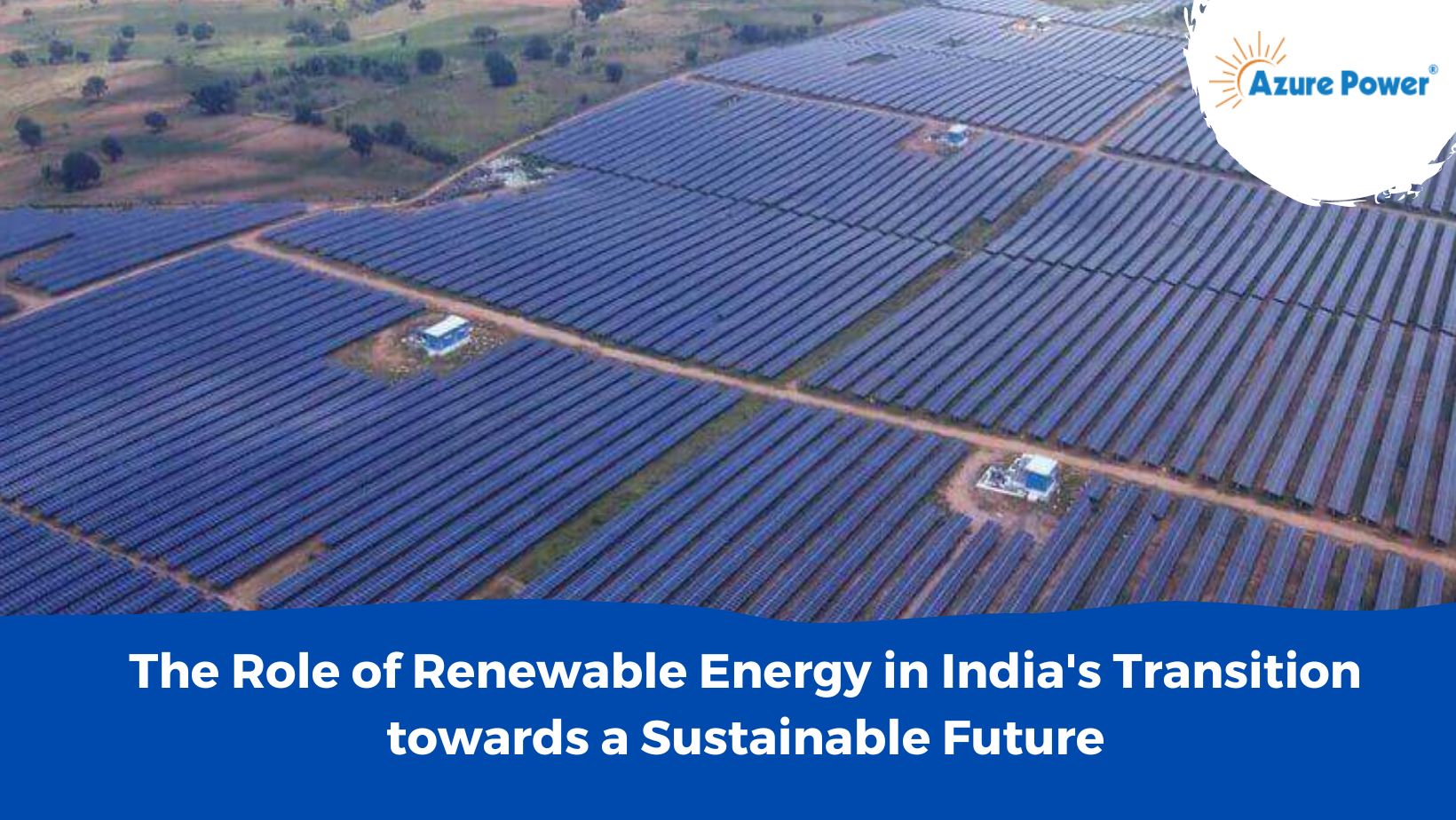Renewable Energy Potential: Mapping India's Transition to a Green Future
India stands at a crucial juncture in its quest for sustainable development, marked by a significant shift towards renewable energy sources. With the pressing need to mitigate climate change and reduce dependence on fossil fuels, the country is increasingly turning to solar energy and other renewables to power its future. This transition is not merely about embracing cleaner sources of energy; it represents a fundamental restructuring of India's energy landscape, with far-reaching implications for its economy, environment, and society.
Embracing Solar Power:
Solar energy has emerged as a cornerstone of India's renewable energy strategy. Blessed with abundant sunlight throughout the year, India possesses immense solar energy potential, making it an ideal candidate for large-scale solar power generation. The government's ambitious targets, such as achieving 100 GW of solar capacity by 2022 and 450 GW by 2030, underscore its commitment to harnessing this abundant resource.
One of the most notable successes in India's solar journey has been the dramatic reduction in solar tariffs. Through competitive bidding processes and technological advancements, the cost of solar power has plummeted, making it increasingly competitive with conventional sources of energy. This cost competitiveness has not only accelerated the deployment of solar projects but has also made solar energy accessible to a wider range of consumers, including industries, commercial establishments, and households.
Beyond Solar: Diversifying the Renewable Portfolio:
While solar energy dominates discussions around India's renewable energy transition, other sources such as wind, hydro, biomass, and geothermal also play crucial roles. Wind energy, in particular, has witnessed significant growth, with India emerging as one of the world's top wind energy producers. Similarly, the untapped potential of hydroelectric power, particularly in regions like the Himalayas, presents opportunities for further expansion.
Moreover, advancements in technology and innovation are opening up new frontiers in renewable energy. From offshore wind farms to floating solar installations and innovations in energy storage, these developments are enriching India's renewable energy portfolio and enhancing its resilience against variability in weather conditions.
Policy Support and Regulatory Framework:
The success of India's energy transition hinges upon a conducive policy environment and robust regulatory frameworks. The government's flagship initiatives, such as the National Solar Mission, the Green Energy Corridor Project, and various state-level policies, provide the necessary impetus for renewable energy deployment. Furthermore, measures such as renewable purchase obligations, net metering, and fiscal incentives are incentivizing investments in clean energy projects.
However, challenges persist, including land acquisition issues, grid integration constraints, and financing hurdles. Addressing these challenges requires a coordinated effort from policymakers, industry stakeholders, and civil society to streamline processes, enhance grid infrastructure, and mobilize investments.
Socioeconomic Impacts and Opportunities:
India's transition to renewable energy is not only about reducing carbon emissions; it also holds immense socioeconomic potential. The renewable energy sector is a significant driver of job creation, offering employment opportunities across the value chain, from manufacturing and installation to operations and maintenance. Moreover, decentralized renewable energy solutions have the potential to empower rural communities by providing access to clean, reliable, and affordable energy.
Furthermore, by reducing dependence on imported fossil fuels, India's renewable energy push enhances energy security and reduces the nation's vulnerability to global energy price fluctuations. This, in turn, strengthens India's economic resilience and fosters sustainable growth.
Conclusion:
India's journey towards a green future powered by renewable energy is both promising and challenging. While significant progress has been made, much work lies ahead to realize the full potential of renewables and achieve the nation's energy transition goals. Collaboration among government, industry, academia, and civil society will be key to overcoming barriers, driving innovation, and accelerating the adoption of clean energy technologies. With steadfast commitment and collective action, India can pave the way for a sustainable, inclusive, and prosperous future powered by renewable energy.
For more information visit us @ https://www.azurepower.com/energy-transition

The Role of Renewable Energy in India's Transition Towards a Sustainable Futur
In recent years, India has emerged as a global leader in renewable energy adoption, spearheading initiatives to transition towards a sustainable future. With a rapidly growing economy and increasing energy demand, the country faces the challenge of meeting its energy needs while minimizing its carbon footprint. In this context, renewable energy has emerged as a key solution, offering not only environmental benefits but also economic opportunities for growth and development.
One of the most promising sectors within renewable energy is solar energy. India boasts abundant sunlight throughout the year, making it an ideal location for harnessing solar power. The government has taken proactive measures to promote solar energy adoption through various policies and incentives, attracting investment from both domestic and international players.
Renewable energy companies have played a crucial role in driving India's transition towards sustainability. These companies specialize in developing, installing, and operating renewable energy projects, including utility-scale solar installations. By leveraging their expertise and resources, they have been able to scale up renewable energy capacity in the country and contribute significantly to reducing carbon emissions.
Utility-scale solar projects, in particular, have witnessed exponential growth in India. These large-scale installations, typically ranging from several megawatts to hundreds of megawatts in capacity, are capable of generating electricity at a competitive cost compared to conventional fossil fuel-based power plants. Moreover, they offer the advantage of scalability and flexibility, making them suitable for meeting the diverse energy needs of industries, commercial establishments, and residential consumers.
The benefits of utility-scale solar go beyond clean energy generation. These projects also create employment opportunities, stimulate local economies, and enhance energy security by reducing reliance on imported fossil fuels. Additionally, they contribute to mitigating climate change by displacing greenhouse gas emissions associated with conventional power generation.
Despite the significant progress made in the renewable energy sector, challenges remain. One of the key challenges is the intermittency of renewable energy sources, such as solar and wind, which can pose reliability issues for the grid. However, advancements in energy storage technologies, coupled with smart grid solutions, are helping to address this challenge by enabling better integration of renewable energy into the grid and enhancing grid stability.
In conclusion, renewable energy, particularly solar energy, plays a pivotal role in India's transition towards a sustainable future. Renewable energy companies, with their expertise and investments, are driving the growth of utility-scale solar projects, thereby contributing to energy security, economic development, and environmental sustainability. As India continues its journey towards achieving its renewable energy targets, collaboration between government, industry, and other stakeholders will be crucial in overcoming challenges and realizing the full potential of renewable energy.
For more information visit us @ https://www.azurepower.com/
Exploring India's Top Renewable Energy Companies and Sustainable Solutions in Utility-Scale Solar
As the world turns towards sustainable energy solutions, India stands at the forefront of the renewable energy revolution. With utility-scale solar projects gaining momentum and a burgeoning market for sustainable energy solutions, India is witnessing a significant shift towards a greener future. In this article, we delve into the realm of utility-scale solar, highlight the top renewable energy companies in India, and explore the innovative endeavors of sustainable energy solutions companies in the country.
1. Utility-Scale Solar: Powering India's Future
Utility-scale solar projects have emerged as a cornerstone of India's renewable energy landscape. These large-scale installations harness solar energy to generate electricity, catering to the growing energy demands of the nation while reducing carbon emissions. With abundant sunlight available throughout the year, India possesses immense potential for solar power generation. Utility-scale solar projects leverage this potential by deploying photovoltaic panels across vast expanses of land, efficiently converting sunlight into clean, renewable energy.
2. Top Renewable Energy Companies in India: Driving the Green Transition
India boasts a vibrant ecosystem of renewable energy companies that are driving innovation and pushing the boundaries of sustainability. From solar power to wind energy and beyond, these companies are leading the charge towards a cleaner, greener future. Some of the top renewable energy companies in India include:
a. Tata Power Solar: A pioneer in solar energy solutions, Tata Power Solar is renowned for its expertise in designing, manufacturing, and deploying solar panels and systems for utility-scale projects as well as residential and commercial applications.
b. Adani Green Energy: With a focus on solar and wind energy, Adani Green Energy is one of the largest renewable energy companies in India, boasting a diverse portfolio of projects aimed at reducing carbon emissions and promoting sustainable development.
c. Suzlon Energy: Specializing in wind energy solutions, Suzlon Energy is a key player in India's renewable energy sector, with a strong track record of delivering high-performance wind turbines and integrated solutions for clean power generation.
These companies, along with several others, are instrumental in driving the adoption of renewable energy technologies and spearheading India's transition towards a low-carbon economy.
3. Sustainable Energy Solutions Companies:
Pioneering Innovation for a Greener Tomorrow. In addition to renewable energy giants, a new wave of sustainable energy solutions companies is emerging in India, offering innovative technologies and holistic approaches to address the challenges of climate change and environmental sustainability. These companies are leveraging cutting-edge technologies such as artificial intelligence, IoT, and blockchain to optimize energy efficiency, manage resources effectively, and promote renewable energy adoption at scale.
a. ReNew Power: A leading renewable energy company, ReNew Power focuses on providing end-to-end solutions for clean energy generation, storage, and distribution. The company's diverse portfolio includes solar, wind, and hydroelectric projects, supported by advanced technologies for efficient energy management.
b. Mahindra Susten: The sustainability arm of the Mahindra Group, Mahindra Susten offers comprehensive energy solutions encompassing solar power, energy storage, and integrated smart grid solutions. With a commitment to sustainability and innovation, Mahindra Susten is driving the transition towards a carbon-neutral future.
c. Azure Power: As one of India's largest solar power producers, Azure Power specializes in utility-scale solar projects, leveraging advanced technologies and scalable solutions to accelerate the deployment of clean energy infrastructure across the country.
These sustainable energy solutions companies are at the forefront of driving innovation and catalyzing positive change in India's energy landscape, paving the way for a more sustainable and resilient future.
Conclusion:
India's journey towards a sustainable energy future is propelled by the collective efforts of utility-scale solar projects, top renewable energy companies, and sustainable energy solutions providers. With a growing emphasis on clean energy adoption, innovation, and sustainability, India is poised to emerge as a global leader in the transition towards a greener, more resilient energy system. As the nation continues to harness the power of renewable resources and embrace sustainable technologies, the possibilities for a cleaner, brighter future are limitless.
For more information visit us @ https://www.azurepower.com/utilities
Navigating Challenges and Solutions in Implementing Utility-Scale Solar Projects
As the world increasingly shifts towards renewable energy sources, utility-scale solar projects stand out as key players in the transition. These projects, characterized by large-scale solar installations designed to feed electricity directly into the grid, offer immense potential in meeting energy demands sustainably. However, their implementation comes with its own set of challenges, requiring innovative solutions to ensure their success. In this article, we delve into the obstacles faced by utility-scale solar projects and explore the solutions that are paving the way for their effective deployment.
1. Land Acquisition and Permitting Hurdles:
One of the primary challenges in implementing utility-scale solar projects revolves around land acquisition and obtaining necessary permits. Securing large tracts of land suitable for solar installations can be a lengthy and complex process, often entailing negotiations with multiple landowners and navigating regulatory requirements. Additionally, obtaining permits from local authorities can pose significant delays, further hindering project timelines.
Solution: Collaborative efforts between project developers, government agencies, and local communities can streamline the land acquisition process. Engaging in transparent dialogue with landowners and offering fair compensation packages can facilitate smoother negotiations. Furthermore, establishing clear regulatory frameworks and expediting permit approvals can expedite project development.
2. Interconnection Challenges:
Integrating utility-scale solar projects into existing electrical grids poses another significant challenge. Ensuring seamless interconnection with the grid while maintaining grid stability and reliability requires careful planning and coordination. Moreover, the location of solar installations may necessitate substantial upgrades to the grid infrastructure, adding complexity and cost to the project.
Solution: Proactive engagement with grid operators and utilities is essential to address interconnection challenges effectively. Conducting thorough grid studies early in the project development phase can identify potential issues and inform necessary upgrades. Implementing advanced grid management technologies, such as smart inverters and energy storage systems, can enhance grid flexibility and mitigate integration challenges.
3. Financial Viability and Investment Risks:
Despite the declining costs of solar technology, utility-scale solar projects still require significant upfront investment, posing financial viability concerns for developers and investors. Moreover, uncertainties surrounding government policies, regulatory frameworks, and fluctuating market conditions can increase investment risks, potentially deterring stakeholders from committing to projects.
Solution: Innovative financing mechanisms, such as power purchase agreements (PPAs) and renewable energy certificates (RECs), can help mitigate financial risks associated with utility-scale solar projects. Offering long-term contracts with fixed electricity prices through PPAs provides revenue certainty, attracting investors seeking stable returns. Additionally, government incentives and subsidies can incentivize private investment in renewable energy projects, further enhancing their financial viability.
4. Technical and Operational Challenges:
Utility-scale solar projects entail complex technical and operational considerations, ranging from site selection and solar panel efficiency to maintenance and performance optimization. Factors such as solar resource variability, equipment reliability, and workforce skill shortages can impact project performance and profitability.
Solution: Investing in advanced solar technology and adopting best practices in project design and construction can address technical challenges and optimize operational efficiency. Implementing rigorous quality control measures throughout the project lifecycle ensures reliable performance and maximizes energy generation. Furthermore, providing specialized training programs for maintenance personnel enhances workforce capabilities, minimizing downtime and optimizing asset performance.
In conclusion, while utility-scale solar projects offer immense potential in advancing renewable energy goals, they are not without their challenges. By addressing issues related to land acquisition, interconnection, financing, and technical operations, stakeholders can overcome barriers to project implementation and unlock the full benefits of utility-scale solar installations. As top renewable energy companies in India and around the world continue to invest in innovative solutions, the future of utility-scale solar looks increasingly promising, driving sustainable energy transformation on a global scale.
For more information visit us @ https://www.azurepower.com/utilities
The Economics of Solar Power in India: Analyzing Costs, Savings, and ROI in the Energy Transition
In recent years, the global focus on sustainable and renewable energy sources has intensified, with solar power emerging as a leading contender in the race towards a greener future. As India strives towards a significant energy transition, solar power has become a pivotal player in reshaping the energy landscape. This article delves into the economics of solar power, examining the costs, savings, and return on investment in the context of India's energy transition, with a special focus on the top renewable energy companies driving this change.
The Energy Transition in India:
India, with its burgeoning population and rapid economic growth, faces the dual challenge of meeting rising energy demand while mitigating the environmental impact. The government's commitment to achieving 175 gigawatts (GW) of renewable energy capacity by 2022, as part of its National Solar Mission, underscores the significance of solar power in India's energy transition.
Top Renewable Energy Companies in India:
Several renewable energy companies have taken center stage in India's solar revolution. Companies like Adani Green Energy, Tata Power Solar, and ReNew Power have not only demonstrated their commitment to sustainability but have also played a pivotal role in driving down the costs associated with solar power generation. These industry leaders have invested heavily in research and development, technological advancements, and large-scale solar projects, making significant contributions to India's clean energy goals.
Analyzing the Costs of Solar Power:
One of the critical factors influencing the adoption of solar power is the cost dynamics associated with its implementation. The initial investment in solar panels and related infrastructure can be substantial, but the decreasing cost of solar technology and government incentives have significantly lowered the barriers to entry. India's solar tariffs have witnessed a steep decline in recent years, making solar power increasingly competitive with traditional fossil fuels.
Savings and Long-Term Benefits:
While the upfront costs may seem daunting, the long-term savings offered by solar power are substantial. Solar panels have a lifespan of 25-30 years, during which they generate clean, renewable energy, significantly reducing or even eliminating electricity bills. As the cost of conventional energy sources continues to rise, solar power offers a stable and predictable source of electricity at a fixed cost.
Return on Investment (ROI):
The return on investment for solar power installations in India has become increasingly attractive. With decreasing installation costs, favorable government policies, and the ability to sell excess electricity back to the grid, businesses and homeowners can recoup their initial investment in a relatively short period. The declining costs of solar technology and the potential for revenue generation through incentives contribute to a compelling ROI for solar power projects.
Government Policies and Incentives:
The Indian government has implemented various policies and incentives to promote solar power adoption. These include subsidies, tax benefits, and net metering, which allows consumers to sell excess electricity back to the grid. Such policies not only make solar power more financially viable but also encourage individuals and businesses to contribute to the country's renewable energy goals.
Conclusion:
The economics of solar power in India are increasingly favorable, with decreasing costs, long-term savings, and an attractive return on investment. The top renewable energy companies in India play a crucial role in driving this transformation, investing in cutting-edge technology and large-scale projects. As the nation continues its energy transition, solar power stands as a key player in shaping a sustainable and eco-friendly future for India.
For more information visit us @ https://www.azurepower.com/energy-transition



